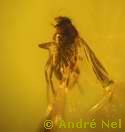Thursday, September 28, 2006
Amazon Amber Fossils Reveal Ancient Biodiversity
 Paris: The discovery of an amber deposit formed in the Amazon during the Miocene epoch proves that the region's rich biological diversity goes back some 16 million years, members of the research team that made the finding told Tierramerica.
Paris: The discovery of an amber deposit formed in the Amazon during the Miocene epoch proves that the region's rich biological diversity goes back some 16 million years, members of the research team that made the finding told Tierramerica.
The Miocene era encompasses the period of Earth's development from between 23 million and five million years ago.
In 2004, a group of researchers from the United States, France, England, Mexico and Peru discovered a small amber deposit embedded with insect fossils and plant matter in the Western Amazon, close to the northern Peruvian city of Iquitos.
The preliminary findings were announced August 28 in Paris by the team, which is coordinated by Pierre Olivier Antoine, a geology researcher with the Paul Sabatier University in Toulouse, France. [Evolution]
Continued at "Fossils Reveal Ancient Biodiversity" (IPS Rome, Italy)
-------
The above expands upon "Amber find shows Amazon as biodiversity hotspot" posted in this blog on Tuesday, August 29, 2006
An associated Proceedings of the National Academy of Sciences (PNAS) paper (co-authored by Pierre Olivier Antoine) is "Amber from western Amazonia reveals Neotropical diversity during the middle Miocene" (Abstract)
The original (August) french press release "Decouverte d'insectes fossiles dans l'ambre d'amazonie" contains a number of images (including a larger version of the one above).
Featured book: George Poinar's "Lebanese Amber: The Oldest Insect Ecosystem in Fossilized Resin" (Amazon UK | US)
Books on Amber Fossils from the Science and Evolution Bookshop: UK | US
Technorati: paris, discovery, amber, deposit, amazon, miocene, epoch, biological, diversity, research, team, era, earth, development, united states, france, england, mexico, peru, insect, evolution, plant, western, northern, peruvian, city, iquitos, pierre, olivier, antoine, geology, researcher, paul, sabatier, university, toulouse, fossils, reveal, ancient, biodiversity, ips, rome, italy, hotspot, proceedings, national, academy, sciences, pnas, amazonia, fossil
Add to: CiteUlike | Connotea | Del.icio.us | Digg | Furl | Newsvine | Reddit | Yahoo